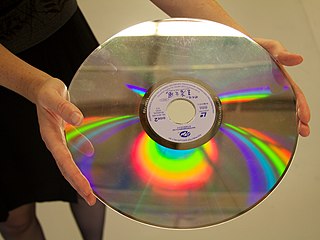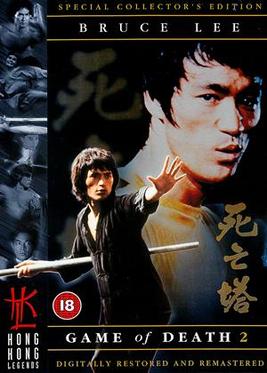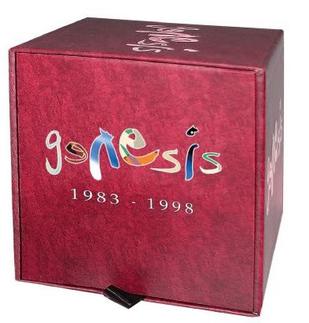Dolby Digital, originally synonymous with Dolby AC-3, is the name for a family of audio compression technologies developed by Dolby Laboratories. Called Dolby Stereo Digital until 1995, it is lossy compression. The first use of Dolby Digital was to provide digital sound in cinemas from 35 mm film prints. It has since also been used for TV broadcast, radio broadcast via satellite, digital video streaming, DVDs, Blu-ray discs and game consoles.
MPEG-1 Audio Layer II or MPEG-2 Audio Layer II is a lossy audio compression format defined by ISO/IEC 11172-3 alongside MPEG-1 Audio Layer I and MPEG-1 Audio Layer III (MP3). While MP3 is much more popular for PC and Internet applications, MP2 remains a dominant standard for audio broadcasting.

DVD-Audio is a digital format for delivering high-fidelity audio content on a DVD. DVD-Audio uses most of the storage on the disc for high-quality audio and is not intended to be a video delivery format.

The LaserDisc (LD) is a home video format and the first commercial optical disc storage medium, initially licensed, sold and marketed as MCA DiscoVision in the United States in 1978. Its diameter typically spans 30 cm (12 in). Unlike most optical-disc standards, LaserDisc is not fully digital, and instead requires the use of analog video signals.

Dolby Laboratories, Inc. is a British-American technology corporation specializing in audio noise reduction, audio encoding/compression, spatial audio, and HDR imaging. Dolby licenses its technologies to consumer electronics manufacturers.
Roy Orbison and Friends: A Black and White Night is a 1988 Cinemax television special originally broadcast on January 3, 1988, presenting a performance by singer/songwriter Roy Orbison and the TCB Band with special guests including Bruce Springsteen, k.d. lang and others. The special was filmed entirely in black and white. After the broadcast, the concert was released on VHS and Laserdisc, and a live album was released in 1989.

5.1 surround sound is the common name for surround sound audio systems. 5.1 is the most commonly used layout in home theatres. It uses five full bandwidth channels and one low-frequency effects channel. Dolby Digital, Dolby Pro Logic II, DTS, SDDS, and THX are all common 5.1 systems. 5.1 is also the standard surround sound audio component of digital broadcast and music.

One Night Only is a live album and DVD/Blu-ray by the Bee Gees. It features the group's concert at the MGM Grand in Las Vegas in 1997 and includes many of their greatest hits.

DTS, Inc. is an American company. DTS company makes multichannel audio technologies for film and video. Based in Calabasas, California, the company introduced its DTS technology in 1993 as a competitor to Dolby Laboratories, incorporating DTS in the film Jurassic Park (1993). The DTS product is used in surround sound formats for both commercial/theatrical and consumer-grade applications. It was known as The Digital Experience until 1995. DTS licenses its technologies to consumer electronics manufacturers.
Dolby Digital Plus, also known as Enhanced AC-3, is a digital audio compression scheme developed by Dolby Labs for the transport and storage of multi-channel digital audio. It is a successor to Dolby Digital (AC-3), and has a number of improvements over that codec, including support for a wider range of data rates, an increased channel count, and multi-program support, as well as additional tools (algorithms) for representing compressed data and counteracting artifacts. Whereas Dolby Digital (AC-3) supports up to five full-bandwidth audio channels at a maximum bitrate of 640 kbit/s, E-AC-3 supports up to 15 full-bandwidth audio channels at a maximum bitrate of 6.144 Mbit/s.

Game of Death II, also known as Tower of Death or The New Game of Death, is a 1981 Hong Kong martial arts film directed by Ng See-yuen and starring Bruce Lee, Tong Lung, Huong Cheng Li and Roy Horan. This film was marketed as a sequel to Bruce Lee's last and only partially completed film Game of Death. Bruce Lee died some years before the production of Game of Death II and most of his scenes are taken from Lee's older films, mostly Enter the Dragon. Aside from the international English dub giving the "Bruce Lee" character the name Billy Lo, this movie appears to have no connection with Robert Clouse's 1978 version of Game of Death.
Dolby TrueHD is a lossless, multi-channel audio codec developed by Dolby Laboratories for home video, used principally in Blu-ray Disc and compatible hardware. Dolby TrueHD, along with Dolby Digital Plus (E-AC-3) and Dolby AC-4, is one of the intended successors to the Dolby Digital (AC-3) lossy surround format. Dolby TrueHD competes with DTS's DTS-HD Master Audio, another lossless surround sound codec.

Guns, God and Government is the third live video album by American rock band Marilyn Manson, released on October 29, 2002 on the formats VHS, DVD and UMD, documenting the tour of the same name. The DVD contains live performances that switch between visuals of various shows from United States, Japan, Russia and Europe while maintaining a single consistent music track.

DTS-HD Master Audio is a multi-channel, lossless audio codec developed by DTS as an extension of the lossy DTS Coherent Acoustics codec. Rather than being an entirely new coding mechanism, DTS-HD MA encodes an audio master in lossy DTS first, then stores a concurrent stream of supplementary data representing whatever the DTS encoder discarded. This gives DTS-HD MA a lossy "core" able to be played back by devices that cannot decode the more complex lossless audio. DTS-HD MA's primary application is audio storage and playback for Blu-ray Disc media; it competes in this respect with Dolby TrueHD, another lossless surround format.

Genesis 1976–1982 is a box set of five studio albums by Genesis. It was released on 2 April 2007 in Europe & Japan by Virgin/EMI and on 15 May 2007 in North America by Atlantic/Rhino. The 6-CD/6-DVD box set includes newly remixed versions of the albums A Trick of the Tail, Wind & Wuthering, ...And Then There Were Three..., Duke, and Abacab. The sixth pair of discs includes B-side songs.

Genesis 1983–1998 is a box set of four studio albums by Genesis. It was released on 1 October 2007 in Europe & Japan by Virgin/EMI and on 20 November 2007 in North America by Atlantic/Rhino. The 5-CD/5-DVD box set includes newly remixed versions of the albums Genesis, Invisible Touch, We Can't Dance, and ...Calling All Stations.... The fifth pair of discs includes B-side songs. Each bonus DVD features audio versions of the albums in 5.1 surround sound, as well as videos for songs from that album and its corresponding tour, new interviews, and photo galleries.

Genesis 1970–1975 is a box set of five studio albums by Genesis featuring Peter Gabriel. It was released on 10 November 2008 in Europe by EMI and on 11 November 2008 in North America by Atlantic/Rhino. The 7-CD/6-DVD box set includes newly remixed versions of the albums Trespass, Nursery Cryme, Foxtrot, Selling England by the Pound and The Lamb Lies Down on Broadway. The band's 1969 debut album, From Genesis to Revelation, was excluded because of the band losing the rights to it. The fifth pair of discs includes B-side songs, 3 rare songs from BBC Sessions in 1970 and the never-before-released Genesis Plays Jackson soundtrack. Each bonus DVD features audio versions of the albums in 5.1 surround sound, as well as videos from each album's corresponding tour, new interviews, and photo galleries. The European version includes CD/SACD Hybrids instead of standard CDs. EMI also released a limited edition six disc vinyl box set containing the original albums only on 24 November 2008.

DVD-Video is a consumer video format used to store digital video on DVDs. DVD-Video was the dominant consumer home video format in Asia, North America, Europe, and Australia in the 2000s until it was supplanted by the high-definition Blu-ray Disc, before eventually both were replaced by streaming services such as Netflix and Disney+. Discs using the DVD-Video specification require a DVD drive and an MPEG-2 decoder. Commercial DVD movies are encoded using a combination of MPEG-2 compressed video and audio of varying formats. Typically, the data rate for DVD movies ranges from 3 to 9.5 Mbit/s, and the bit rate is usually adaptive. DVD-Video was first available in Japan on November 1, 1996, followed by a release on March 26, 1997, in the United States—to line up with the 69th Academy Awards that same day.












